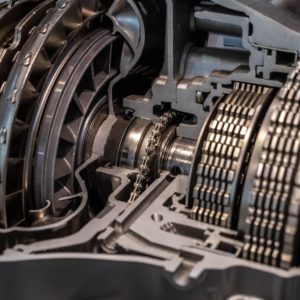The torque converter is a critical part of automatic transmission vehicles because it is responsible for transferring engine torque to the transmission. It is also responsible for allowing the engine to run at a standstill with the transmission in gear. All modern torque converters also have a lockup clutch. If you think your torque converter clutch has issues, you should connect a scan tool to check if a code, such as P2770, has been stored.
What Does the P2770 Code Mean?
Diagnostic trouble code (DTC) P2770 stands for “Torque Converter Clutch Circuit High.” The torque converter is composed of an impeller and turbine. The turbine connects to the engine while the impeller connects to the transmission. During normal vehicle operation, the engine spins the turbine, which sends hydraulic fluid to spin the impeller. This process transfers torque from the engine to the transmission without a direct mechanical connection.

Once the vehicle reaches a certain speed, the torque converter lockup clutch will engage and mechanically connect the impeller and turbine. This allows the engine to operate more efficiently since there isn’t any energy lost from the impeller and turbine rotating at different speeds.
The powertrain control module (PCM) or transmission control module (TCM) operates the torque converter lockup clutch via a solenoid. When the TCM detects a problem with the torque converter clutch solenoid or its circuit, it may set code P2770.

Note: The definition of code P2770 might be different depending on the vehicle manufacturer. Consult the appropriate repair manual or repair database for the exact code definition.
What are the Common Causes of the P2770 Code?
The issues that trigger the P2770 code are commonly caused by the following issues:
- Faulty transmission clutch solenoid
- Faulty TCM
- Circuit problems, such as a damaged wire or poor connection
- Valve body problem
- Internal transmission or torque converter failure

What are the Common Symptoms of the P2770 Code?
You might experience the following symptoms if the P2770 is stored:
- Illuminated check engine light
- Decreased fuel economy
- Transmission might not shift properly
- Torque converter doesn’t operate as designed
How to Diagnose the P2770 Code
The P2770 is a generic powertrain code that can be logged in most vehicles with an OBD-II system. While this code can be logged in most modern vehicles, remember that diagnosing this trouble code can vary depending on vehicle specifications.
If you’re not familiar with the process of diagnosing trouble codes (DTCs), it might be best to have a trained mechanic do the job for you. However, you can also do it yourself if you think you’re confident in your DIY skills.
Interested in diagnosing your problem yourself? Watch the video below to get an idea of what the process might involve.
How to Fix the P2770 Code
Without the right tools and technical knowledge, it can be hard to repair a P2770 code. You might need to access parts inside your vehicle’s transmission, which can be a laborious task. Under these circumstances, it might be best to bring your vehicle to the nearest repair shop and have a certified mechanic resolve the issue. But if you think you have the experience and automotive know-how to work on your vehicle, make sure to follow the right steps and observe the necessary protocols before you begin.
Keep in mind that there isn’t a fix-all solution that will resolve any trouble code, which is why it’s important to have the right resources. Guides like those from Chilton or an ALLDATA subscription contain vehicle-specific repair information, so you might want to check those out before you begin.
Any information provided on this Website is for informational purposes only and is not intended to replace consultation with a professional mechanic. The accuracy and timeliness of the information may change from the time of publication.


















